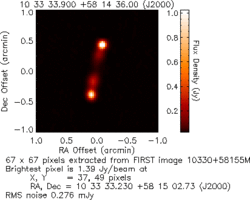3C 244.1
Topic: Astronomy
 From HandWiki - Reading time: 2 min
From HandWiki - Reading time: 2 min
| 3C 244.1 | |
|---|---|
 | |
| Observation data (Epoch J2000) | |
| Constellation | Ursa Major |
| Right ascension | 10h 33m 33.90s[1] |
| Declination | +58° 14′ 36.0″[1] |
| Redshift | 0.43 |
| Type | [1] |
| Apparent magnitude (V) | 19 |
| Other designations | |
| Ursa Major B, DA 287, LEDA 2821461, 3C 244.1, 4C 58.21. | |
| See also: Quasar,List of quasars]] | |
Ursa Major B or 3C 244.1 is a radio galaxy located in the constellation Ursa Major.
It is classified as a Fanaroff-Riley Type II (FRII) radio source, which means that the luminosity increases with distance from the core. There are two, asymmetrical radio-emitting lobes straddling the parent galaxy. These lobes have an angular separation of 52″ at a position angle of 168°. When measured in the optical band, this galaxy has a redshift value of z = 0.428, corresponding to a distance of 1.5 Gpc. 3C 244.1 is located within a cluster of other galaxies.[2]
Observations with the Hubble Space Telescope show an elliptical galaxy with blobs and a filamentary structure. The radio jets being generated by the active galactic nucleus are interacting with the interstellar medium, producing extended narrow line regions. These features are commonly associated with many active galaxies.[2] The axial ratio of the elliptical galaxy is 1.4, meaning it is about 1.4 times large along the primary axis than along the perpendicular axis.[3]
At the nucleus of this galaxy is a supermassive black hole with an estimated (9.5 ± 6.6) × 108 solar masses. The dimensionless ratio of the black hole spin to the black hole mass-energy j is 0.12 ± 0.04.[4]
See also
References
- ↑ 1.0 1.1 1.2 "NASA/IPAC Extragalactic Database". Results for QSO B1030+585. http://nedwww.ipac.caltech.edu/.
- ↑ 2.0 2.1 Feinstein, Carlos; Macchetto, F. Duccio; Martel, André R.; Sparks, William B. (January 2002). "Filaments and Ionized Gas in the Vicinity of 3C 244.1". The Astrophysical Journal 565 (1): 125–130. doi:10.1086/324604. Bibcode: 2002ApJ...565..125F.
- ↑ McLure, Ross J. (2004). "A sample of radio galaxies spanning three decades in radio luminosity - I. The host galaxy properties and black hole masses". Monthly Notices of the Royal Astronomical Society 351 (1): 347–361. doi:10.1111/j.1365-2966.2004.07793.x. Bibcode: 2004MNRAS.351..347M.
- ↑ Daly, Ruth A. (February 2009). "Black Hole Spins of Radio Sources". The Astrophysical Journal Letters 691 (2): L72–L76. doi:10.1088/0004-637X/691/2/L72. Bibcode: 2009ApJ...691L..72D.
External links
- www.jb.man.ac.uk/atlas/
- "NAME UMa B". SIMBAD. Centre de données astronomiques de Strasbourg. http://simbad.u-strasbg.fr/simbad/sim-basic?Ident=NAME+UMa+B.
Coordinates: ![]() 10h 33m 33.90s, +58° 14′ 36.0″
10h 33m 33.90s, +58° 14′ 36.0″
 |
 KSF
KSF